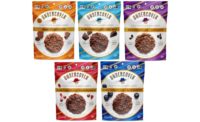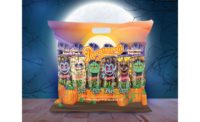![]()
Power Retailing at Costco Wholesale
By Mary Ellen Kuhn
Shoppers are flocking to warehouse club stores, and no
one does this unique brand of larger-than-life retailing better than
Costco.
Costco is Confectioner’s 2004
Retailer of the Year, but we aren’t the only ones to note the
achievements of the nation’s sixth-largest retailer.
Costco gets plenty of positive press. In recent
months, stories have appeared on the pages of USA Today, The Wall Street
Journal and Business Week, to mention just a few of the most celebrated.
“They are one of the strongest merchants in
retailing today,” says consultant Neil Stern, a partner at
Chicago-based McMillan/Doolittle LLP.
“Costco is clearly the best operator within the
club channel,” observes Todd Hale, senior vice president, Consumer
Insights, at New York-based ACNielsen. “With fewer stores, they
are able to outsell Sam’s Club,” he continues. “They
drive greater shopper frequency, and they drive greater basket ring.”
Costco’s ascent to the ranks of retailing powerhouses
has been rather dramatic.
“They weren’t on the map five years ago,
and now they’re clearly designated as one of the power retailers of
the future,” says Don Stuart, managing director, Cannondale
Associates. The retailer’s position will become even more prominent
within the next decade or so, Stuart predicts.
For the past seven years, Cannondale, a sales and
marketing management consulting firm with offices in Wilton, Conn., and
Evanston, Ill., has been conducting a survey designed to provide insights
into the operations of top-performing retailers and manufacturers. In the
2004 PowerRanking Survey, Costco made the list of top 10 retailers with a
composite score that was up 2.9 percent over the prior year. (Retailers are
ranked by vendors on criteria that include achievements in areas such as
purchasing and category management, among others.)
One survey participant had these words of praise for
the Issaquah, Wash.-based warehouse club store, founded just 21 years ago.
“Costco is on a roll,” the survey respondent said. “They
have a very clear go-to-market strategy. They are very focused on tightly
controlled retail, and they put a great product in the box.”
“Costco has about twice the sales per
square foot of Sam’s,” which is its main competitor in the
wholesale club store class of trade, adds Stuart.
On target
Costco’s success in targeting higher-income
consumers with ample discretionary income—both via its merchandise
assortment and the location of its stores—contributes significantly
to the sales volume per building (which is how Costco executives refer to
their warehouse club units).
“This is a chain that does very well in
appealing to consumers who can afford to shop in the channel,” Hale
observes. “You need to be able to afford the membership, and you need
to be able to shop a lot when you’re there,” he says.
The merchandise assortment provides some major clues
into the affluence of the Costco customer. For example, it’s not
unusual to find a display of Dom Perignon champagne for sale at Costco,
notes Brian Harris, founder and co-chairman of The Partnering Group, a
Playa del Rey, Calif.-based consulting group.
“One of the things that I think Costco has done
very well is to identify its consumer base,” says retail consultant
Thomas Aquilina, president of Aquilina & Associates Inc., Crystal Lake,
Ill. “I think that’s supported by their (membership) retention
rates,” Aquilina continues. He points out that 85 percent of Costco
members renew their memberships each year.
“I think consumers know that Costco stands for
quality and a great price,” says Aquilina. “And I think
consumers feel satisfied that they’re getting that.”
Hale links some of Costco’s appeal to its
ability to deliver a shopping experience that is pleasant and relatively
straightforward. “I think simplicity and pace of life issues come
into play,” he says, reflecting that the sheer volume of SKUs
featured in supermarkets and mass merchandisers can lead to mental overload
for some shoppers.
Acing the assortment
Because of the limited number of SKUs featured in the
building, the pressure is on warehouse club buyers to get the assortment
right, and Costco succeeds admirably at that.
As Stern points out, warehouse club stores like Costco
carry only about 4,000 SKUs per building vs. 40,000 for a supermarket, and
up to 100,000 for a mass merchandiser. “The warehouse club model
requires the companies to be very, very good about identifying the products
they select to sell,” says Stern.
And that, of course, means that Costco buyers must be exceptionally
savvy and well informed.
“Their buyers are very bright people,” says
Ted File, managing partner, C2-It Inc. Associates, Naperville, Ill., a
management/mentoring advisory company. “The buyers are held
responsible for turnover and margin,” he says. “They scrutinize
every item.” And they’re particularly well versed about the
cost of goods, he adds.
Working with vendors
Not surprisingly, breaking into Costco as a new vendor
can be challenging. Once an appointment is granted, says Aquilina,
“They want to taste the product before they do anything else.”
If the taste isn’t first-rate, the process will stop right there.
Once taste criteria are met, the buyer will start talking price.
“They’re really tough in their decision-making process,
and not always timely,” says Aquilina.
Just as Costco’s appeal to consumers is
straightforward, so too is its relationship with vendors. Not counting
product quality, which must be a given, it’s all about high-volume
sales and rapid turn.
“The good news about Costco,” says Stern
of McMillan-Doolittle “is that it’s hard to get in, but you get
in based on performance. You’re not working with slotting fees and
advertising rebates or all the games that certain channels play. It’s
about performance as well as giving them the best price.”
Vendors must also be prepared to satisfy Costco’s stringent
supply chain requirements.
“If you sell to Costco, you’d better have 100 percent
fill and 100 percent on-time delivery,” says Aquilina.
Amy Paulose, business development manager for Fife,
Wash.-based Ames International, gives Costco buyers high marks for
creativity and willingness to collaborate. “I think the buyers are
very much empowered to come up with their own creative ideas,” says
Paulose.
For the holidays this year, Ames International is
supplying Costco with chocolate-covered macadamia nuts as well as an
attractively packaged nutcracker/nuts-in-the shell item.
Douglas Chu, co-president of Beverly Hills,
Calif.-based Taste of Nature/Shari Candies, rates the chain highly for
organization and information sharing.
“They’re very forthcoming with vendors as
to what their needs and requirements are, which ultimately leads to better
merchandising solutions,” he says.
“They seem to have very good communication among their
regional offices,” adds Chu.
Industry players and watchers note that one of the
things that sets Costco apart from many other retailers is its effective
use of regional buyers to help augment the assortment selected at
headquarters. “You can sell to
corporate, and you can sell to the regional offices,” says Paulose.
The big-picture view
Costco turned in a strong performance for the 2004
fiscal year. Sales climbed 13 percent to $47.15 billion, and net income
increased 22 percent to $882.4 million.
In fact, Costco has performed so strongly that
it’s tough to find much to criticize. Some would say, however, that
its strengths and weaknesses are closely connected.
For example, President and CEO Jim Sinegal is a firm
believer in treating Costco employees well. Not only is it the right thing
to do, he has said, it also results in a highly efficient and productive
work force. According to consultant Aquilina, 85 percent of Costco
employees are eligible for benefits, and after four years, the average
salary for a cashier is $41,000. Not surprisingly, Costco can claim
excellent employee retention. About 80 percent of employees are retained
each year.
Sinegal’s commitment to marking products up no
more than 14 percent over cost is nearly legendary. It’s a strategy
that wins consumer loyalty, but it gives the huge retailer less flexibility
when it comes to rising costs in areas such as employee benefits.
As employee costs increase, “Costco
doesn’t have the ability to raise margins to reflect that,”
Stern reflects. “If they’re vulnerable at all, it’s that
the model is very rigid in terms of their ability to get more money from
their stores.
“Most retailers have a lot of ways to massage
the balance sheet—run more advertising to get more bodies in the
store, raise margins to generate higher profits,” Stern continues.
“But the club model in general and Costco in particular doesn’t
allow for that. They don’t advertise. A lot of retailers take margins
where they can get it…Costco doesn’t do that.”
Looking forward
Harris says that he expects Costco, as well as other
key warehouse club store players, Sam’s Club and BJ’s, to
continue to refine their respective positions in the marketplace.
Sam’s Club initiated a renewed focus on small
business shoppers in 2003 and 2004, and BJ’s has been working to
drive more sales among families and also is targeting foodservice
operators, according to Hale.
Costco continues to focus on both business and
household shoppers. And when it comes to targeting households, Costco
enjoys the advantage of targeting more upscale consumers than does
Sam’s Club, which tends to focus on consumers of more moderate means.
“I think that what’s going to test the
model is their building location selection,” says Aquilina.
“It’s not right for every place. Their real estate department
has to do a lot of research to make sure that the target audience aligns
with the Costco model.”
Hale offers this summary of the not-so-secret ingredients in
Costco’s formula for success.
“Consumer research has shown that the channel receives
high marks in providing a pleasurable shopping experience,” says Hale.
“Who cares if sometimes you have to wait in long checkout lanes and if
boxes aren’t always available for your purchases? It is the treasure hunt
for bargains, the limited assortment that simplifies the shopping experience,
and the constant delivery of value that wins shoppers.”


